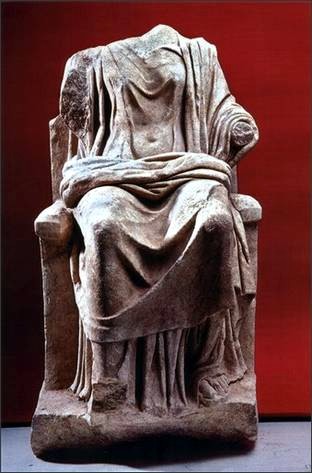Un descubrimiento arqueológico en Grecia reúne a Zeus y Hera
The headless, marble statue of the ancient Greek goddess Hera dates back to the 2nd century B.C. and was discovered last year during excavations in the town of Dion, near Mt Olympus in northern Greece. Photo: AP
El profesor Dimitris Pantermalis, afirma que la escultura es del siglo II a.c. y es la parte que faltaba de una excepcional doble estatua que adornaba el antiguo templo de Zeus.
Salónica, Grecia.- Un equipo de arqueólogos descubrió cerca del Monte Olimpo una escultura de Hera, diosa del matrimonio en la mitología griega, que -junto a una estatua de Zeus hallada recientemente- permitiría constituir la primera pareja de deidades en la historia de Grecia, informó AFP.
La estatua de Hera, sin cabeza y de talla humana, es del siglo II AC. Fue descubierta en un muro defensivo, en Dion, un santuario religioso situado en el norte del país, muy importante durante la civilización macedónica. "Es posible que (el conjunto) incluyera la estatua de Atena", afirmó el arqueólogo Dimitris Pantermalis, en la presentación oficial del hallazgo el viernes en la ciudad de Salonica.
La estatua de Hera, según los especialistas, tiene las mismas dimensiones y el mismo estilo que una escultura de Zeus, hallada en el mismo lugar en 2003. La mitología griega recoge numerosas historias entre Zeus y Hera. Dion, situada en las laderas del Monte Olimpo, cuna de las divinidades griegas, fue una antigua ciudad fortificada y un centro religioso muy importante durante la civilización macedónica, entre el período griego y romano.
Excavaciones anteriores habían permitido descubrir dos teatros, un estadio y varias partes relacionadas con una gran variedad de dioses, como las divinidades egipcias Sarapis, Isis y Anubis, cuya influencia en el mundo griego aumentó durante la conquista de Alejandro el Grande.
Fuente: El Universal, 2 de marzo de 2007
Enlace: http://deportes.eluniversal.com/
2007/03/02/ten_ava_02A840601.shtml
Greek archaeologists find Hera statue
Headless marble statue found in a city under Mount Olympus
By Costas Kantouris
THESSALONIKI, Greece - A 2,200-year-old statue of the goddess Hera has been found built into the walls of a city under Mount Olympus, home of Greeces ancient gods, archaeologists said on Thursday. The headless marble statue was discovered last year during excavations in the ruins of ancient Dion, some 53 miles southwest of Thessaloniki.
Archaeologist Dimitris Pantermalis said the life-sized by human dimensions statue had been used by the early Christian inhabitants of Dion as filling for a defensive wall.
He said the 2nd century B.C. find appeared to have originally stood in a temple of Zeus, head of the ancient Greek gods whose statue was found in the buildings ruins in 2003 and after whom Dion was named.
"We have reached the conclusion that the statue of Hera stood next to that of Zeus in the temple," said Pantermalis, a Thessaloniki University professor who has headed excavations at Dion for more than three decades.
Hera was the long-suffering wife of Zeus, a notorious philanderer, according to ancient mythology.
"The statue represents a female form seated on a throne, and is made of thick-grained marble like the one of Zeus," Pantermalis said. "It shows exactly the same technique and size, which led us to link the two statues beyond doubt."
Pantermalis said that, if confirmed, it would be the first time two statues of different gods have been located from a single temple in Greece. He said it was also possible that a statue of Athena, goddess of wisdom, could have stood in the temple of Zeus, and expressed hopes it might be discovered during future excavations.
Dion was a major religious center of the ancient Macedonians. Alexander the Great offered sacrifices there before launching his victorious campaign against the Persian Empire in the 4th century B.C.
Excavations so far have revealed temples, theaters and a stadium, city walls, a hotel, baths and streets with an elaborate drainage system, as well as many statues.
The area was first inhabited during the Iron Age, and survived into early Christian times when it was the seat of a bishop.
Pantermalis will present the find on Friday, during a three-day archaeological conference that opened in Thessaloniki Thursday.
The Associated Press, March 1, 2007
Source: http://www.msnbc.msn.com/id/17406301/

0 comentarios